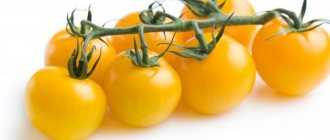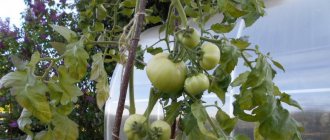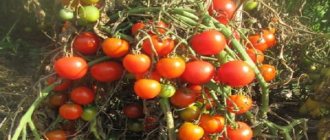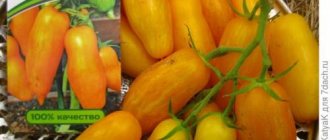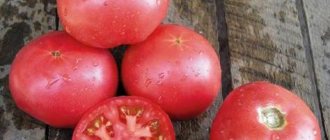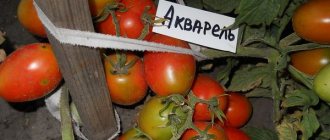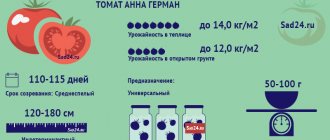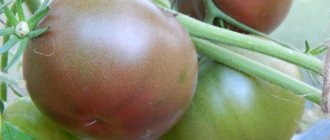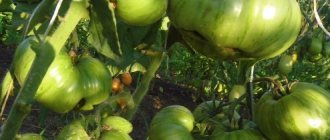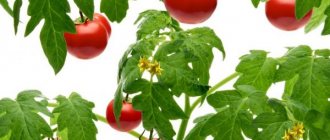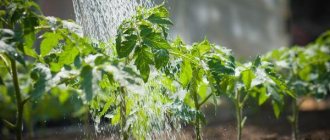Description of the variety
The average weight is from 15 to 20 cm.
Fruit:
- Round, even shape;
- Not ripe - light green in color; those that have reached maturity - transparent pink in color;
- With tough skin;
- With juicy, not watery pulp;
- With a sweet taste, with a slight sourness;
- Number of seed chambers - 2;
- Quite small in size.
Bushes:
- Determinate type, with creeping stem;
- Height reaches from 20 to 40 cm;
- The leaves are small, light green in color;
- Inflorescence of intermediate type;
The formation of the first inflorescence occurs after 6-7 leaves, subsequent ones at intervals of 1-2 leaves.
- The peduncle has an articulation.
Harvest: prospects
From 1 bush they harvest 1-1.5 kg, from 1 m2 the yield is 6 kg.
The Red Pearl variety does not have high yields. One bush will not produce more than 1.5 kg. Tomatoes with a planting scheme of 4 bushes per 1 sq. m you can get up to 6 kg. However, given the size of the plant, not everything is so sad.
If good conditions have been created and proper care is provided, up to 3-4 kg of harvest can be harvested from each bush. Accordingly, from 1 m2 the yield reaches from 16 to 18 kg.
Due to its excellent tolerance to temperature changes in the middle zone, the tomato variety can be grown even in unprotected soil, and not just in the southern regions. Tomatoes are cultivated in greenhouses and at home throughout Russia.
Tomatoes: advantages and disadvantages
The tomato variety “Garden Pearl” has the following positive qualities:
- High productivity;
- Unpretentiousness in care;
- Product appearance;
- Compactness;
- Decorative;
- Early ripening;
- The presence of resistance to fruit cracking;
- Ability for long-term storage;
Among the disadvantages of the variety are increased demands on the type of soil and lighting conditions.
- Possibility of transportation over long distances;
- Long fruiting period.
Tomatoes Pearl: Siberia, Yellow, Red, Pink
The Pearl tomato has more than 5 different types, each worthy of special attention.
Description of Pearl tomatoes
Characteristic
Pearl is a relatively new type of tomato. It is grown both in greenhouses and in open ground, the main thing is constant watering and fertilization. This type of tomatoes is classified as decorative. The plant loves sunny and warm places.
The bushes are small in size, 30-40 cm. The growth of the plant at the time of ripening depends on the size of the pot in which the tomatoes are kept. Pearl tomatoes come in the following types:
- pearls of Siberia;
- yellow pearl;
- red pearls;
- pink pearl.
Features of the view
Each type from this family has a number of differences:
- productivity;
- unpretentiousness;
- excellent taste;
- Red color;
- resistance to diseases;
- ease of cultivation.
Pearl of Siberia
The Pearl of Siberia is a new type of tomato bred in this region. It is famous for its high yield and excellent taste. It is grown using seeds and is not a hybrid type. The Pearl of Siberia has a strong and strong root system, which makes it possible to grow in any conditions and still produce a good harvest; the entire system develops in width.
The bush grows to almost 145 cm, the stem is strong and powerful, and has several clusters with fruits. The leaves of this plant are small in size, shaped like potatoes, and dark green.
The variety gives good yield: on average, more than 8 fruits are obtained from one gem. Ripening is average, the first fruits are obtained after 110 days. The description of tomatoes is simple: they are round, tasty, and easy to grow.
The ripening process is interesting: first the lower and then the upper fruits ripen. The plant has good immunity, which facilitates the growing process
Red Pearl
This variety is suitable for growing at home
The fruits have a decorative basis; they are grown both in gardens and at home on the windowsill. The red pearl grows small, maximum 34-45 cm. The fruits are small, somewhat reminiscent of cherry tomatoes. One fruit weighs 25-35 g. The total number of chambers reaches 2, the percentage of dry substances is not higher than 6%.
The downside is that such tomatoes do not last long after assembly, so it is impossible to transport the product over long distances.
The variety perfectly combines acid and sugar. More than 1.5 kg is collected from one bush, and from 4 bushes per 1 sq. m receive over 6 kg. According to the description, the advantages of the variety are:
- the ability to grow tomatoes at home;
- fast ripeness;
- adaptability to lack of lighting;
- ability to withstand sudden temperature changes;
- resistance to diseases;
- ease of care.
Yellow pearl
Yellow pearls are mini tomatoes. The fruits of this garden crop are yellow. The plant is unpretentious and easy to grow. The main thing is to water it on time and sometimes give additional vitamins and fertilizers. Yellow pearl is a determinate hybrid.
The fruits ripen quickly, from the moment of planting to the moment of harvesting, 84-94 days pass. The plant is low: maximum height - 61 cm, minimum - 35 cm. It all depends on which parents are chosen for it. Mature fruits are bright yellow in color, round and small in shape.
The weight of one fruit is 20-35 g. It is recommended to tie the bushes to lighten the load on the plant. Positive characteristics of the variety:
- good resistance to lack of light;
- ability to withstand sudden temperature changes without loss of yield;
- high percentage of resistance to diseases and pests.
pink pearl
Pink Pearl is a determinate variety with early ripening. From planting to harvest it takes 82 to 86 days. The bushes grow small: 65-75 cm in height. Fully ripened fruits have a pinkish tint with red dots. Their weight ranges from 91 g to 95 g.
Indoor tomatoes Growing tomatoes in winter Open ground tomatoes in Siberia
One fruit contains 2-3 chambers; the bush contains a total of 5% dry matter. Pink Pearl tomatoes are an excellent choice for yield. Advantages of the plant:
- adaptability to any conditions;
- undemanding to lighting;
- resistance to temperature changes;
- immunity to diseases and pests.
The branches cannot withstand the load, so they are tied up. The plant is constantly watered and given calcium and vitamins. Growing varieties is easy and simple.
Growing tomatoes
Like all tomato crops, the Garden Pearl variety is cultivated through seedlings.
How to prepare seeds?
To improve germination, seed material is soaked for 10 hours in any growth stimulant of your choice.
Sowing seed material
Description:
- For growing at home, seeds are sown in early February. When planning further planting in a greenhouse structure, seed material is sown in the second ten days of March, in unprotected soil - in April;
- For sowing, mineral-rich, well-drained soil is preferred. Fill the planting container with the substrate and add compost or vermiculite;
- The seeds are buried 0.5 cm. The soil temperature should be no lower than +15 degrees;
- Next, the seedlings are given 16-18 hours of daylight. Water the seedlings and feed them with complex mineral fertilizers twice during the entire growth period;
- The appearance of a pair of full-fledged leaves serves as a signal for seedlings to be planted in separate pots with a diameter of 7.5 cm.
Rules for planting seedlings
Description:
- Young seedlings are planted in a greenhouse structure or in unprotected soil as soon as the soil has completely warmed up. At the time of transplantation, seedlings should have 7-8 full leaves and one flower cluster;
- To grow tomatoes, give preference to open areas with sufficient sunlight. The soil is pre-fertilized with manure, peat and nitrogen fertilizers;
- The seedlings are planted using a 50x40 cm pattern. The compact size of the bush allows you to place from 7 to 10 tomato bushes per 1 m2.
How to grow ampel tomatoes
Canopy varieties can be grown under film, in beds in open ground and in greenhouses. There they require obligatory garter, bear fruit well and become similar to ordinary tomatoes.
When planted in hanging baskets to decorate a house or territory, ampelous tomatoes require a large amount of mineral fertilizers and constant treatments. In potted culture, you need to choose - beauty and a lot of fruits that are of little use for eating, or a modest harvest and not very presentable bushes.
Preparing soil and seeds
Sowing seeds for seedlings to grow balcony hanging tomatoes is usually carried out a month earlier than for soil. There, when moving to a permanent place, you need to wait until the soil warms up well.
Seedlings are grown in the same way as for conventional varieties. It is better not to prepare the soil yourself - there is a danger of introducing an infection or pests with one of the components that can destroy tender young plants.
Steaming with boiling water does not provide a 100% guarantee of the destruction of pathogenic spores and larvae. Of course, you can bake all the ingredients in the oven, but this is time-consuming and messy. It is better to buy a ready-made substrate for seedlings. Its quality is quite acceptable and the price is low.
There is no need to prepare pelleted seeds for planting - any manipulation violates the integrity of the shell. Conventional ones are first disinfected in a convenient way, then heated at a temperature of 53 ° C, then planted.
Experienced gardeners, if they soak tomato seeds, do so only until they swell, and never wait for them to peck.
Landing
Ampelous tomatoes are sown in low wooden boxes. To avoid picking, you can use peat or plastic cups with a hole made at the bottom for the outflow of water with a volume of no more than 0.5 liters, or special pallets.
First, the container is filled with substrate, compacted well, paying special attention to the area along the sides, and leveled. For the top 5 cm, the soil mixture is sifted to avoid lumps and tamped lightly.
Furrows are made at a distance of 1-1.5 cm from each other, about 1 cm deep, and seeds are rarely sown. Level the surface and water by spraying from a household spray bottle.
As an option, just mark the grooves, lay out the tomato seeds according to a 1x1 cm pattern, cover with a 2 cm layer of substrate. Compact with a spoon. Watered. Cover with film or glass and place in a warm place. The planting is ventilated daily and the soil moisture is checked.
The seeds germinate better at a temperature of 28-32° C - they only need 4 or 5 days.
At 20-23°C you will have to wait a week. If the temperature is below 18° C, the seeds not only hatch poorly, but can also rot in wet soil.
After germination, the containers are moved to the brightest place. The temperature is reduced to 16-18° during the day, 12-14° C at night. Seedlings that emerge with a delay of 4-5 days are immediately discarded.
Picking
Tomato seedlings are picked when 2-3 true leaves appear. The seedlings are immediately planted in individual containers with a capacity of 0.5 liters. You can use plastic cups with holes in the bottom. If the seeds were planted in pallets or separate containers, picking is not required.
The operation is conveniently carried out with a special wooden peg. It is planed at one end like a screwdriver, but so that the edge is blunt and cannot damage the plants.
The peg is driven into the aisle, pointing the flat surface towards the young tomatoes. Press in the opposite direction from them. Gently pull it out of the soil, holding the seedlings by the cotyledon leaf. If the root is too long, pinch it off, leaving about 4 cm. Seedlings with a shorter shoot are also plucked, they will take root well.
Using the same peg, make a deep notch in the cups. Insert the tomato into the hole so that the root fits completely there and does not bend. Stick a peg next to it and press the substrate against the plant, covering the lower part.
Planting depth – up to the cotyledon leaves. It’s even better to carefully pinch them off first. And bury the tomato down to the real leaves. But only experienced dive operators can do this without injuring the seedling.
Water the tomatoes carefully. Place it for 2-3 days away from the sun and lighting fixtures. If necessary, cover with newspaper. Tomato roots recover quickly, and after a few days the seedlings can be returned to their usual conditions.
Feeding and watering
Watering tomato seedlings should be sufficient, but not excessive. An overdried plant will quickly die, an overwatered plant will get blackleg, fall, and have to be thrown away.
Tomatoes are very demanding when it comes to fertilizing from the moment they emerge. If they were sown in a store-bought substrate, there is nothing to worry about for a while - it contains all the necessary additives.
The first time tomato seedlings are fed 12 days after picking. It is better to use special fertilizers for tomatoes, diluted 2 times more than indicated in the instructions. Additionally, urea is added to the fertilizer at the rate of 1 teaspoon per 10 liters of water. Although tomatoes do not like excess nitrogen, at this stage it is very necessary.
A week later, a second feeding is carried out. If the tomatoes develop normally, this is the limit. If growth is delayed, fertilize the seedlings every 2 weeks. If the leaves and shoots of tomatoes turn purple, it means they lack phosphorus, light, or are cold.
The main rules of feeding:
- fertilize early in the morning or in cloudy weather;
- the fertilizing is completely dissolved, there should be no crystals left, otherwise they will burn the seedlings;
- use warm, settled water;
- pre-moisten the soil;
- It is better to underfeed than to overfertilize.
Transplantation to a permanent place
Depending on the variety, containers from 5 to 10 liters are used. Some tomatoes allow planting in 3-liter pots. There should be holes at the bottom to drain excess moisture.
You can take greenhouse soil prepared for planting tomatoes as a substrate, or make it yourself from equal parts of well-rotted humus, turf soil and peat. Add a glass of ash and 1 tbsp as a starting fertilizer. a spoonful of double superphosphate per 10 liters of mixture.
At the bottom of the pot, drainage made of expanded clay, broken red brick or gravel is laid in a layer of at least 5 cm. The wet substrate is poured, squeezed, and a recess is made in the center corresponding to the size of the container in which the seedlings were grown.
Carefully remove the tomato from the container, trying not to destroy the earthen lump. Place it in the hole, add soil, and water it. There is no need to crimp so as not to damage the roots. The substrate will compact itself when watering. Add soil again. If tomatoes were grown in a peat cup, do not remove it before planting.
They try to plant tomatoes as deep as possible. Adventitious roots quickly form on their stems, providing additional nutrition and stability. The part of the shoot that will be underground must be freed from the leaves so that they do not rot.
The containers are placed in the shade for several days. As soon as new leaves appear, they are placed in a permanent place.
Bush care
The “Garden Pearl” tomato variety does not require any special care:
- The main advantages of the variety are that there is no need for pinching and bush formation;
- Frequent watering is not recommended. Otherwise, excessive moisture can cause rotting of the root system, which will cause the loss of the entire crop. The frequency of watering is once every 14 days, after the soil under the bushes has completely dried. The water consumption rate per bush is from 4 to 5 liters;
- The first fertilizing is carried out when the ovary appears, adding fertilizers enriched with phosphorus and potassium to the soil. Agricola and bio-infusions with the addition of bird droppings are also used as fertilizers;
- To avoid the stem lying on the soil, it must be provided with vertical support and tied up;
- Loosen the soil in the beds once or twice a week;
- Weeding is carried out weekly, destroying all weeds.
Characteristics
- The amazing Garden Pearl is an ultra-early ripening variety. She will delight you with a harvest within 87 - 93 days after the appearance of full shoots;
- The crumb yield is excellent due to the growth of side shoots on which fruit clusters appear. According to different sources, this figure is quite high - from 2.0 to 7.0 kg of tomatoes per bush. True, the State Register notes that 4.8 kg per 1 square meter was collected under film covers;
- the fruiting period is long, the plant will form ovaries before the onset of persistent cold weather;
- there is no specific data on immunity, but the Garden Pearl is reported to be resistant to major diseases;
- fruits are resistant to cracking;
- transportability is good, tomatoes can withstand the hardships of transportation. Keeping quality, according to reviews, is long-lasting if storage standards are followed;
- method of use is universal. Children love to pick sweet tomatoes and eat them in their natural form. You can make a salad from the fruits and decorate the finished dish with them. Another advantage of the variety is the ability to use it in whole-fruit canning.
Reviews about the variety from those who planted
The good commercial characteristics of the fruits of the tomato variety “Garden Pearl” allow it to be grown for sale in containers. Fruits with excellent taste are enjoyed not only by adults, but also by children.
By growing the “Garden Pearl” tomato variety, you can not only get a good harvest, but also decorate your greenhouse structure and open beds. Thanks to the possibility of cultivating at home, urban residents who do not have the opportunity to grow tomatoes in their garden plots also fell in love with the tomato variety.
Tomato varieties for the greenhouse:
Diseases and pests
The Pink Pearl tomato variety is resistant to most diseases. When planted in open ground in the second half of summer, a tomato may develop late blight. To avoid problems, plants are regularly inspected, fruit-bearing shoots are cut off, and sprayed with a phytosporin solution.
If the disease manifests itself in the form of curled or blackened leaves, the bushes are sanitized and the affected branches are removed. Copper sulfate, Bordeaux mixture and fungicides are used for control.
Tomatoes are rarely affected by pests. Among the most common are whiteflies and spider mites. Most often they appear in greenhouses. They are fought with chemicals.
Diseases and insect attacks
Diseases and insects do not attack the Red Pearl bushes. The only thing that can cause concern is incorrect care. Lack of fresh air will kill plants indoors. The same balcony should be ventilated regularly.
Melon aphids and thrips - these insects can attack tomatoes of this variety. The medicine “Zubr” will help to cope with them. Mole crickets and slugs are standard pests against which simple loosening of the soil will help.
Spraying with a homemade preparation will not hurt:
We invite you to familiarize yourself with: The best varieties of plums for the Moscow region
- bucket with 10 liters of water;
- a spoonful of ground pepper, hot or mustard.
Everything is mixed and applied to the bushes. The pests then disappear.
Application of fruits
The fruits are mainly consumed fresh, as they contain a large amount of vitamins. They can also become a real decoration for any salad. Housewives use tomatoes for home canning and pickles. Can be used for the production of juices and tomato pastes.
The characteristics and description of the Garden Pearl variety are as follows:
- This plant has a creeping stem. The bush has a height of 0.2 to 0.4 m, so there is no need to tie it to supports.
- The ripening time of fruits from the moment of sowing seedlings to obtaining a full harvest is 85-95 days.
- Garden Pearl tomatoes have a good taste with medium berry density.
- The cluster may develop from 8 to 10 berries, colored pink.
- The fruits are spherical in shape and pink in color. The weight of the berries ranges from 15 to 20 g.
- The skin does not crack, and the plant itself does not require care.
Reviews from farmers growing this variety show that the yield per bush can range from 7 to 10 kg. The more berries the gardener removes from the bush, the longer the plant bears fruit. Farmers note the tomato’s demands on soil quality and site illumination.
You can grow the Garden Pearl tomato throughout Russia. In the southern regions of the country, planting is carried out directly in open ground in mid-April-early May. In greenhouse blocks in the middle zone and northern regions, seedlings are planted in the last ten days of February. Since this variety is miniature in size, many gardeners grow these tomatoes on balconies and loggias of multi-story buildings.
We invite you to familiarize yourself with: Industrial cages for rabbits; modular cages for rabbits, model
Some gardeners decorate their garden plots with this variety, growing plants in boxes or baskets specially installed around the perimeter of the yard. The fruits are used in salads. For the winter, they preserve the whole thing and make it into juices, tomato paste, and ketchup.
